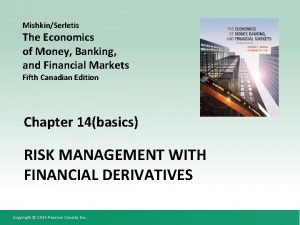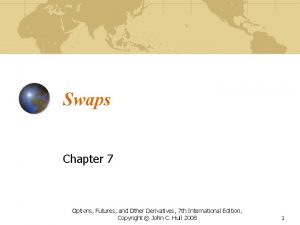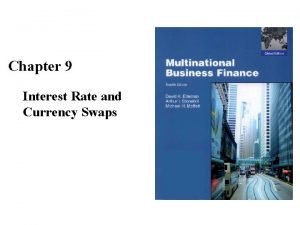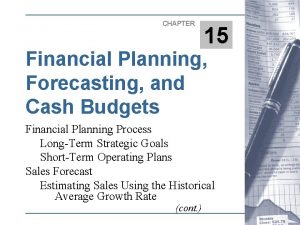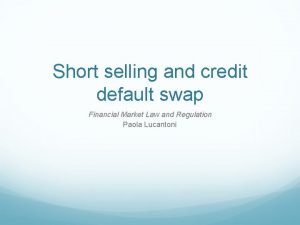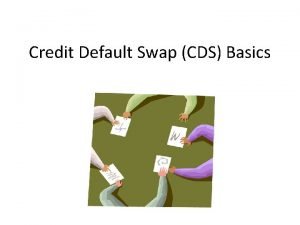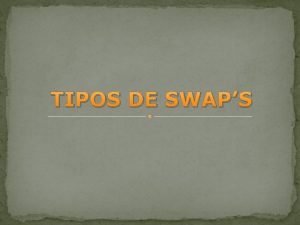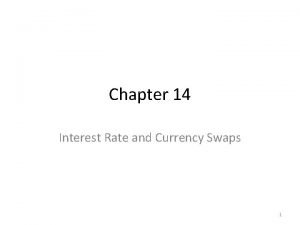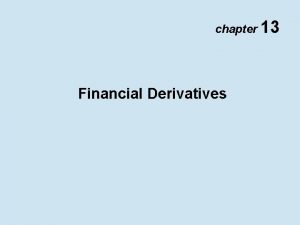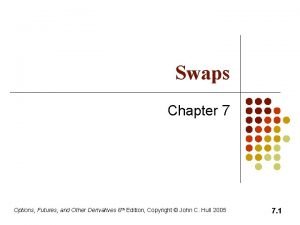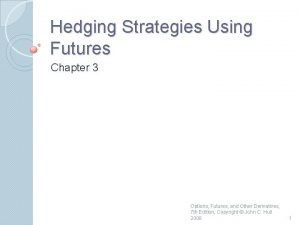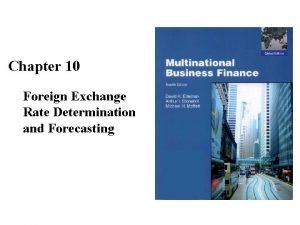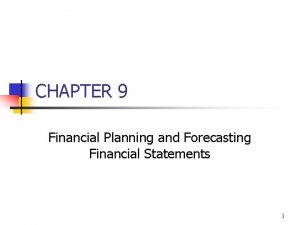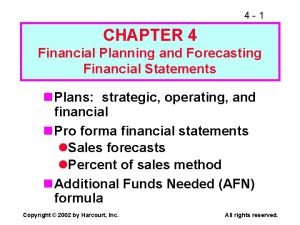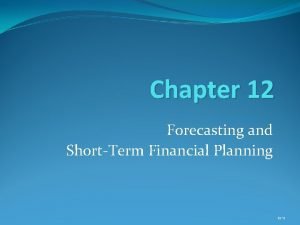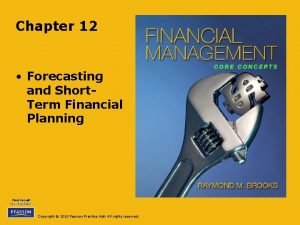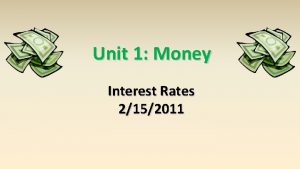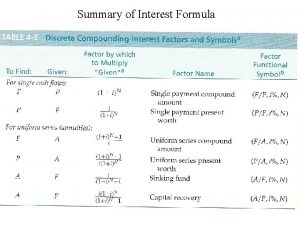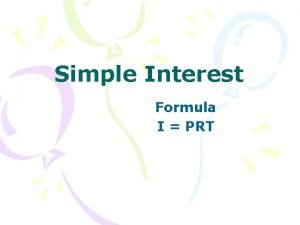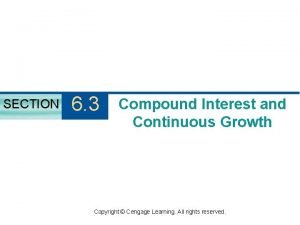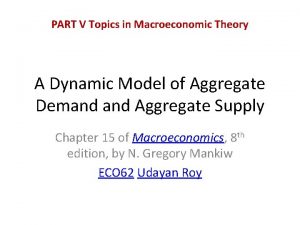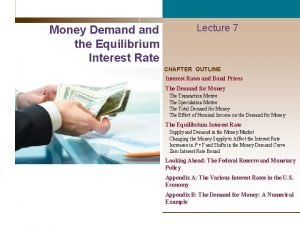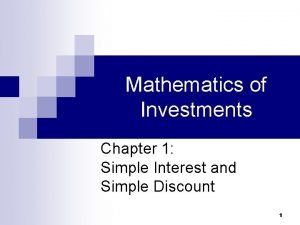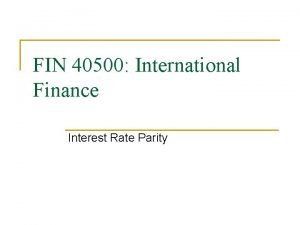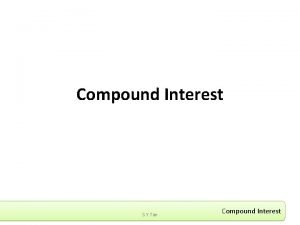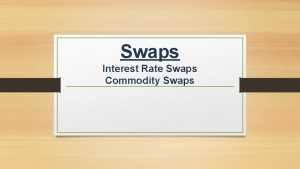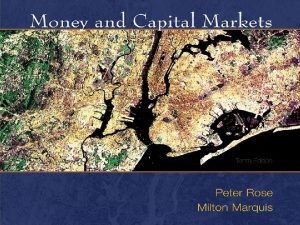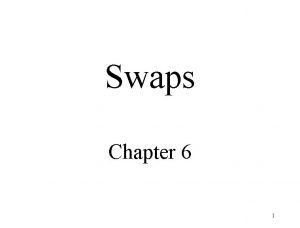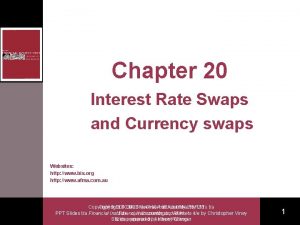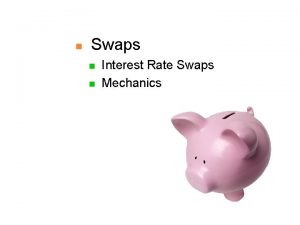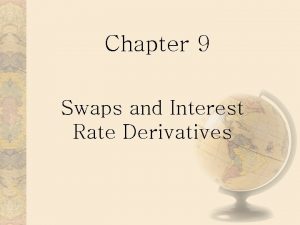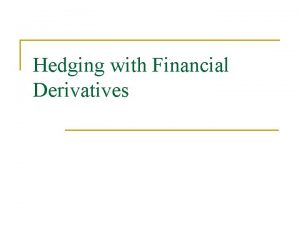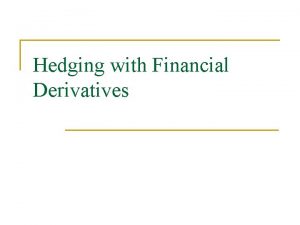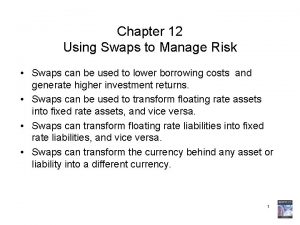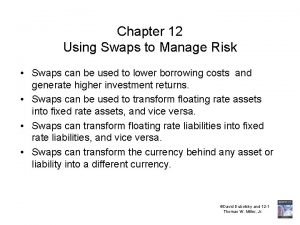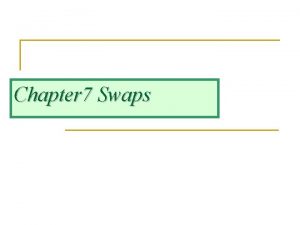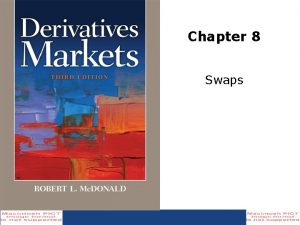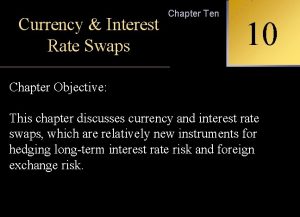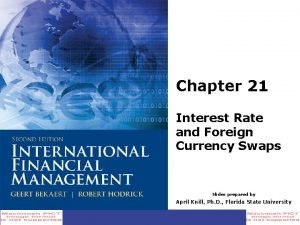Chapter 9 Interest Rate Forecasting Hedging Swaps Financial














































- Slides: 46


Chapter 9 • Interest Rate Forecasting & Hedging: Swaps, Financial Futures, & Options

9 -3 Learning Objectives • To understand why financial analysts today usually choose hedging (protecting) against losses from changing interest rates and asset prices rather than attempting to forecast interest rates or the prices of financial assets. • To examine several popular hedging tools, including interest rate swaps, financial futures, and option contracts. Mc. Graw-Hill/Irwin Money and Capital Markets, 9/e © 2006 The Mc. Graw-Hill Companies, Inc. , All Rights Reserved.

9 -4 Introduction • For actively traded assets, demand supply forces are continually shifting, such that investors interested in these assets must constantly stay abreast of the latest developments. • It is thus no wonder that accurate interest-rate and asset-price forecasting is so difficult, if not impossible. Mc. Graw-Hill/Irwin Money and Capital Markets, 9/e © 2006 The Mc. Graw-Hill Companies, Inc. , All Rights Reserved.

9 -5 Interest-Rate and Asset-Price Forecasting • If interest rates can be forecasted accurately, borrowers can borrow when rates are supposed to be the lowest, while lenders can target the expansion of their lending programs to those periods when interest rates are expected to be the highest. • Unfortunately, forecasting interest rates is far from easy, and may be virtually impossible. Mc. Graw-Hill/Irwin Money and Capital Markets, 9/e © 2006 The Mc. Graw-Hill Companies, Inc. , All Rights Reserved.

9 -6 Interest-Rate and Asset-Price Forecasting • There are, however, a few predictable aspects to interest-rate and asset-price movements. • To understand these few regularities and how the financial markets account for them can significantly reduce the exposure of one’s investments to interest-rate and price movements and minimize market risk. Mc. Graw-Hill/Irwin Money and Capital Markets, 9/e © 2006 The Mc. Graw-Hill Companies, Inc. , All Rights Reserved.

9 -7 Interest-Rate and Asset-Price Forecasting • Interest rates tend to fall (and debt security prices rise) during a business recession, and rise (and debt security prices fall) during an economic expansion. • These phases of the business cycle may last months or years. Mc. Graw-Hill/Irwin Money and Capital Markets, 9/e © 2006 The Mc. Graw-Hill Companies, Inc. , All Rights Reserved.

9 -8 Interest-Rate and Asset-Price Forecasting • In general, short-term interest rates tend to be more sensitive to business cycle changes than long-term interest rates on bonds and other capital market securities. • On the other hand, long-term asset prices tend to be more volatile than the prices of short-term assets. Mc. Graw-Hill/Irwin Money and Capital Markets, 9/e © 2006 The Mc. Graw-Hill Companies, Inc. , All Rights Reserved.

9 -9 Interest-Rate and Asset-Price Forecasting Mc. Graw-Hill/Irwin Money and Capital Markets, 9/e © 2006 The Mc. Graw-Hill Companies, Inc. , All Rights Reserved.

9 - 10 Interest-Rate and Asset-Price Forecasting • There is evidence that interest rates also display seasonality, tending to be higher at some times of the year than at others. • For example, some short-term rates tend to rise through summer and autumn as businesses stock their shelves for the Fall season. Mc. Graw-Hill/Irwin Money and Capital Markets, 9/e © 2006 The Mc. Graw-Hill Companies, Inc. , All Rights Reserved.

9 - 11 The Economy, Interest Rates, and the Daunting Challenge of Forecasting • While we may not be able to consistently make accurate point forecasts, we may be more successful at making directional forecasts. • Unfortunately, the economy can be very difficult to forecast too. • Furthermore, research increasingly suggests that interest rates come close to following a random walk, although they appear to exhibit mean reversion over the very long run. Mc. Graw-Hill/Irwin Money and Capital Markets, 9/e © 2006 The Mc. Graw-Hill Companies, Inc. , All Rights Reserved.

9 - 12 Implied Rate and Price Forecasting • Some financial analysts and active market investors place considerable weight on what is called implied forecasting. • This forecasting technique relies upon measures of the public’s expectations to help predict the future. • In particular, expectations about future interest rates are embedded in the market prices of financial assets. Mc. Graw-Hill/Irwin Money and Capital Markets, 9/e © 2006 The Mc. Graw-Hill Companies, Inc. , All Rights Reserved.

9 - 13 Interest Rate and Asset Price Hedging Strategies • Hedging refers to the act of coordinating the buying and selling of a commodity or financial claim to protect against the risk of future price fluctuations. • Hedging tends to lower interest rate and price risk. However, it also tends to reduce the profit potential that could result from future interest rate and asset price changes. Mc. Graw-Hill/Irwin Money and Capital Markets, 9/e © 2006 The Mc. Graw-Hill Companies, Inc. , All Rights Reserved.

9 - 14 Interest Rate and Asset Price Hedging Strategies • The most popular hedging tools used today include interestrate swaps, financial futures, and option contracts. Mc. Graw-Hill/Irwin Money and Capital Markets, 9/e © 2006 The Mc. Graw-Hill Companies, Inc. , All Rights Reserved.

9 - 15 Interest Rate Swaps Mc. Graw-Hill/Irwin Money and Capital Markets, 9/e © 2006 The Mc. Graw-Hill Companies, Inc. , All Rights Reserved.

9 - 16 Interest Rate Swaps • The result is usually lower interest expense for both firms and a better balance between cash inflows and outflows for both firms. Mc. Graw-Hill/Irwin Money and Capital Markets, 9/e © 2006 The Mc. Graw-Hill Companies, Inc. , All Rights Reserved.

9 - 17 Interest Rate Swaps • Swaps work because the interest-rate spreads related to default risk (called quality spreads) are generally greater in the longterm capital market than they are in the short-term money market. Mc. Graw-Hill/Irwin Money and Capital Markets, 9/e © 2006 The Mc. Graw-Hill Companies, Inc. , All Rights Reserved.

9 - 18 Interest Rate Swaps Suppose Can borrow in the long-term the short-term bond market at loan market at Low-credit-rated borrower High-credit-rated borrower 11% 10% Prime rate + 0. 50% Prime rate Quality spread 1% 0. 50% • In this case, both firms can save on interest costs if each borrows in the market in which it has the comparative interest cost advantage. Mc. Graw-Hill/Irwin Money and Capital Markets, 9/e © 2006 The Mc. Graw-Hill Companies, Inc. , All Rights Reserved.

9 - 19 Interest Rate Swaps The Swap Agreement Low-credit-rated borrower gets a short-term loan from its bank at a floating interest rate (prime rate +. 50%), but pays out the fixed interest cost on the long-term bonds issued by its swap partner. Saves 0. 25% on long-term rate. Mc. Graw-Hill/Irwin Money and Capital Markets, 9/e High-credit-rated borrower issues long -term bonds Pays 10% carrying a fixed interest rate (10%), but pays out a Pays prime rate portion of the floating short-term –. 25% interest rate owed by its swap partner. Saves 0. 25% on short-term rate. © 2006 The Mc. Graw-Hill Companies, Inc. , All Rights Reserved.

9 - 20 Interest Rate Swaps • Today, borrowers often negotiate swap agreements with lenders at the same time as when they reach an agreement on a loan. Mc. Graw-Hill/Irwin Money and Capital Markets, 9/e © 2006 The Mc. Graw-Hill Companies, Inc. , All Rights Reserved.

9 - 21 Interest Rate Swaps The Synthetic Fixed-Rate Loan Borrower Swap agreement: Pays fixed interest rate Pays floating interest rate Lender or other swap partner Loan Pays floating agreement: loan rate Lender Mc. Graw-Hill/Irwin Money and Capital Markets, 9/e © 2006 The Mc. Graw-Hill Companies, Inc. , All Rights Reserved.

9 - 22 Interest Rate Swaps • Swaps help to cover interest-rate risk but do not necessarily reduce credit (default) risk. • However, because the notional amount of a swap is not at risk, a swap is typically less risky than a bond. • Note that swaps themselves are subject to interest-rate risk shifts in market interest rates can alter the value of existing swap agreements. Mc. Graw-Hill/Irwin Money and Capital Markets, 9/e © 2006 The Mc. Graw-Hill Companies, Inc. , All Rights Reserved.

9 - 23 Financial Futures Contracts • In a typical financial futures contract, the seller agrees to deliver a specific security at a specific price at a specific time in the future. • Hedging in futures does not reduce risk. Instead, it is a lowcost method of transferring the risk of unanticipated changes in prices or interest rates from one investor or institution to another. Mc. Graw-Hill/Irwin Money and Capital Markets, 9/e © 2006 The Mc. Graw-Hill Companies, Inc. , All Rights Reserved.

9 - 24 Financial Futures Contracts • Hedging through futures essentially involves adopting equal and opposite positions in the spot and futures markets for the same assets. • The basis for a futures contract is the spread between the spot price of an asset and the forward price for that same asset at the same point in time. • Hedging through futures converts price or interest rate risk into basis risk. Mc. Graw-Hill/Irwin Money and Capital Markets, 9/e © 2006 The Mc. Graw-Hill Companies, Inc. , All Rights Reserved.

9 - 25 Financial Futures Contracts • An investor can sell financial futures contracts on an asset to protect against the risk that the asset’s price may fall. • At the delivery date, the seller can deliver the security, if he or she holds it; buy the security in the spot (cash) market and deliver it; or purchase a futures contract for the same security with the same delivery date (offsetting or zeroing out). Mc. Graw-Hill/Irwin Money and Capital Markets, 9/e © 2006 The Mc. Graw-Hill Companies, Inc. , All Rights Reserved.

9 - 26 Financial Futures Contracts • Today, most of the trading in financial futures centers upon contracts calling for the delivery of - domestic and foreign government notes and bonds - Eurodollar and other Eurocurrency deposits - Federal funds loans and Treasury bills - common stock indices (e. g. S&P 500) - foreign currencies (e. g. ¥, €) - interest-rate swaps Mc. Graw-Hill/Irwin Money and Capital Markets, 9/e © 2006 The Mc. Graw-Hill Companies, Inc. , All Rights Reserved.

9 - 27 Financial Futures Contracts Leading Futures and Options Exchanges Around the World Mc. Graw-Hill/Irwin Money and Capital Markets, 9/e © 2006 The Mc. Graw-Hill Companies, Inc. , All Rights Reserved.

9 - 28 Financial Futures Contracts Mc. Graw-Hill/Irwin Money and Capital Markets, 9/e © 2006 The Mc. Graw-Hill Companies, Inc. , All Rights Reserved.

9 - 29 Financial Futures Contracts • Basically, three types of hedges are used in the financial futures market today. A long hedge involves the purchase of futures contracts today by an investor who must buy the actual securities at a later date. A short hedge involves the sale of futures contracts today by an investor who must sell the actual securities at some later point. A cross hedge involves futures contracts where the underlying asset is different from the actual asset that must be traded at a later date. Mc. Graw-Hill/Irwin Money and Capital Markets, 9/e © 2006 The Mc. Graw-Hill Companies, Inc. , All Rights Reserved.

9 - 30 Financial Futures Contracts An Example of a Long Futures Hedge Mc. Graw-Hill/Irwin Based on an example developed by the. The Chicago Board. Companies, of Trade Inc. , All Rights Reserved. Money and Capital Markets, Source: 9/e © 2006 Mc. Graw-Hill

9 - 31 Financial Futures Contracts An Example of a Short Futures Hedge Mc. Graw-Hill/Irwin Based on an example developed by the. The Chicago Board. Companies, of Trade Inc. , All Rights Reserved. Money and Capital Markets, Source: 9/e © 2006 Mc. Graw-Hill

9 - 32 Financial Futures Contracts Profits from buying futures contracts (the long hedge) Fp - original purchase price Profits from selling futures contracts (the short hedge) Fp - original purchase price Profit Fp Area of gain 0 Fp – Fp Loss Mc. Graw-Hill/Irwin Money and Capital Markets, 9/e Futures contract (or asset) price 0 Area of gain Fp Futures contract (or asset) price Loss © 2006 The Mc. Graw-Hill Companies, Inc. , All Rights Reserved.

9 - 33 Option Contracts on Financial Futures • An option contract is an agreement between a buyer and seller (the option writer) to grant the holder of the contract the right to buy or sell a futures contract or some other specified asset at a specified price (the strike price) before the contract expires. • Call options give the contract holder the right (but not the obligation) to buy, while put options give the right to sell. Mc. Graw-Hill/Irwin Money and Capital Markets, 9/e © 2006 The Mc. Graw-Hill Companies, Inc. , All Rights Reserved.

9 - 34 Option Contracts on Financial Futures Examples of Price Quotations on Option Contracts Mc. Graw-Hill/Irwin Money and Capital Markets, 9/e © 2006 The Mc. Graw-Hill Companies, Inc. , All Rights Reserved.

9 - 35 Option Contracts on Financial Futures • The two most common uses of options involve protecting an investment against falling by using call options interest rates Before-tax profit = market price – strike price – option premium protecting an investment against rising interest rates by using put options Before-tax profit = strike price – market price – option premium Mc. Graw-Hill/Irwin Money and Capital Markets, 9/e © 2006 The Mc. Graw-Hill Companies, Inc. , All Rights Reserved.

9 - 36 Option Contracts on Financial Futures Payoffs to the Option Buyer from Put Options Pr - option premium, S - strike price Profit 0 Payoffs to the Option Writer from Put Options Pr - option premium, S - strike price Value of futures contract (or asset) Area of gain S Pr 0 – Pr Loss Mc. Graw-Hill/Irwin Money and Capital Markets, 9/e Area of gain S Value of futures contract (or asset) Loss © 2006 The Mc. Graw-Hill Companies, Inc. , All Rights Reserved.

9 - 37 Option Contracts on Financial Futures Payoffs to the Option Buyer from Call Options Pr - option premium, S - strike price Profit 0 Payoffs to the Option Writer from Call Options Pr - option premium, S - strike price Profit S – Pr Loss Mc. Graw-Hill/Irwin Money and Capital Markets, 9/e Area of gain Value of futures contract (or asset) Pr 0 Area of gain Value of futures contract (or asset) S Loss © 2006 The Mc. Graw-Hill Companies, Inc. , All Rights Reserved.

9 - 38 Risks, Costs, and Rules for Trading In Derivatives • Futures and options trading has its risks and costs. - Risks: basis risk, margin risk, liquidity risk - Costs: brokerage fees, margin accounts • The decision to trade financial futures and option contracts is a cost versus benefit issue. Mc. Graw-Hill/Irwin Money and Capital Markets, 9/e © 2006 The Mc. Graw-Hill Companies, Inc. , All Rights Reserved.

9 - 39 Risks, Costs, and Rules for Trading In Derivatives • The rapid expansion of derivatives trading has also led to new accounting rules to promote fuller disclosure of risk exposures and to permit management and outsiders to judge the effectiveness of these hedging techniques. Mc. Graw-Hill/Irwin Money and Capital Markets, 9/e © 2006 The Mc. Graw-Hill Companies, Inc. , All Rights Reserved.

9 - 40 Markets on the Net • • Chicago Board of Trade at www. cbot. com Chicago Board Options Exchange at www. cboe. com Chicago Mercantile Exchange at www. cme. com Commodity Futures Trading Commission at www. CFTC. com Mc. Graw-Hill/Irwin Money and Capital Markets, 9/e © 2006 The Mc. Graw-Hill Companies, Inc. , All Rights Reserved.

9 - 41 Markets on the Net • London International Financial Futures and Options Exchange at www. liffe. com • The American Stock Exchange at www. amex. com • The Brussels Exchange at www. tripadvisor. com • The Financial Pipeline: Derivatives Concepts at www. finpipe. com/derivglossary. htm Mc. Graw-Hill/Irwin Money and Capital Markets, 9/e © 2006 The Mc. Graw-Hill Companies, Inc. , All Rights Reserved.

9 - 42 Markets on the Net • The International Securities Exchange at www. iseoptions. com • The New York Board of Trade at www. nyce. com • The Pacific Exchange at www. pacificex. com Mc. Graw-Hill/Irwin Money and Capital Markets, 9/e © 2006 The Mc. Graw-Hill Companies, Inc. , All Rights Reserved.

9 - 43 Chapter Review • Introduction • Interest-Rate and Asset-Price Forecasting - The Business Cycle and Seasonality - The Economy, Interest Rates, and the Daunting Challenge of Forecasting - Implied Rate and Price Forecasting • Interest-Rate and Asset-Price Hedging Strategies Mc. Graw-Hill/Irwin Money and Capital Markets, 9/e © 2006 The Mc. Graw-Hill Companies, Inc. , All Rights Reserved.

9 - 44 Chapter Review • Interest Rate Swaps - What are Swaps? - How Swaps Work - The Risks of Swapping Mc. Graw-Hill/Irwin Money and Capital Markets, 9/e © 2006 The Mc. Graw-Hill Companies, Inc. , All Rights Reserved.

9 - 45 Chapter Review • Financial Futures Contracts - The Nature of Futures Trading Why Hedging Can Be Effective The Purpose of Trading in Financial Futures Assets Covered by Financial Futures Contracts The Exchanges Where Futures Trading Occurs Types of Hedges • Long (Buying), Short (Selling) and Cross Hedges - Payoff Diagrams for Long and Short Futures Contracts Mc. Graw-Hill/Irwin Money and Capital Markets, 9/e © 2006 The Mc. Graw-Hill Companies, Inc. , All Rights Reserved.

9 - 46 Chapter Review • Option Contracts on Financial Futures - Basic Types of Option Contracts - Uses of Options - Payoff Diagrams for Valuing Options • Risks, Costs, and Rules for Trading in Derivatives - Risks and Costs Associated with Futures and Options - Accounting Rules for Transactions Involving Derivatives Mc. Graw-Hill/Irwin Money and Capital Markets, 9/e © 2006 The Mc. Graw-Hill Companies, Inc. , All Rights Reserved.
 Advantages of interest rate swaps
Advantages of interest rate swaps Nominal v. real interest rates
Nominal v. real interest rates Hedging interest rate risk with futures
Hedging interest rate risk with futures Interst rate swap
Interst rate swap Considering interestrate swaps, the swap rate is
Considering interestrate swaps, the swap rate is Cap rate interest rate relationship
Cap rate interest rate relationship Chapter 15 financial forecasting for strategic growth
Chapter 15 financial forecasting for strategic growth Selling credit default swaps
Selling credit default swaps Credit default swap ppt
Credit default swap ppt Credit default swap
Credit default swap Banker swaps rat race for bus lane
Banker swaps rat race for bus lane Mercados de forwards y swaps
Mercados de forwards y swaps Tipos de swaps
Tipos de swaps Unwinding swaps
Unwinding swaps Forwards vs futures vs options vs swaps
Forwards vs futures vs options vs swaps Swaps example
Swaps example Hedging strategies using futures
Hedging strategies using futures Effective annual rate
Effective annual rate 0 965
0 965 Exchange rate forecasting techniques
Exchange rate forecasting techniques Exchange rate determination and forecasting
Exchange rate determination and forecasting Financial planning and forecasting
Financial planning and forecasting Financial planning and forecasting
Financial planning and forecasting Objectives of financial planning and forecasting
Objectives of financial planning and forecasting Financial planning and forecasting problems with solutions
Financial planning and forecasting problems with solutions Financial analysis planning and forecasting
Financial analysis planning and forecasting Financial planning budgeting and forecasting
Financial planning budgeting and forecasting Short term and long term cash forecasting
Short term and long term cash forecasting Interest rate effect
Interest rate effect Discrete interest formula
Discrete interest formula I = p r t
I = p r t All the formula of simple interest
All the formula of simple interest How to write compound interest formula
How to write compound interest formula Nominal interest rate equation
Nominal interest rate equation Taylor rule formula
Taylor rule formula Effective interest rate formula
Effective interest rate formula Money demand and interest rate
Money demand and interest rate Interest rate transmission mechanism
Interest rate transmission mechanism Contractionary monetary policy
Contractionary monetary policy How to find principal amount
How to find principal amount Purchasing power parity formula
Purchasing power parity formula Quotes
Quotes Cheapest to deliver futures
Cheapest to deliver futures Interest rate parity
Interest rate parity Uncovered interest rate parity formula
Uncovered interest rate parity formula Formula for maturity value
Formula for maturity value Interest rate parity example
Interest rate parity example
